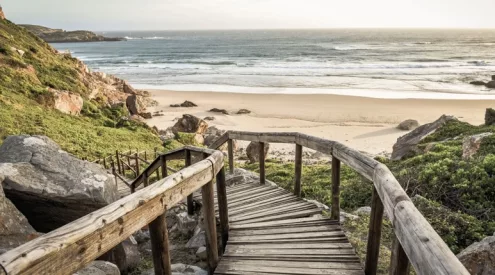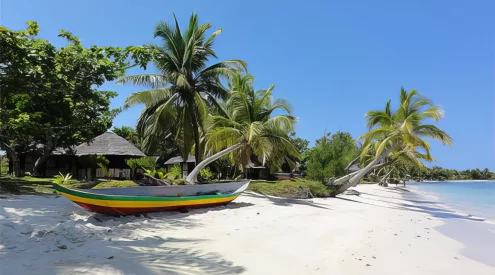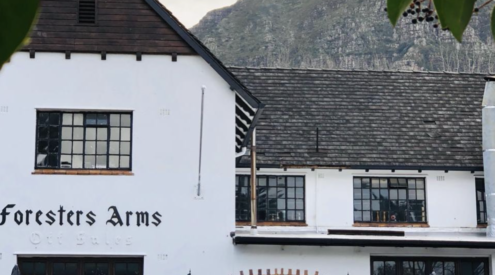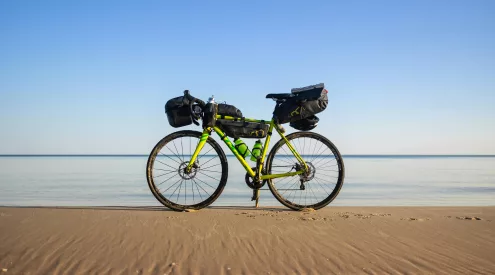If you’ve been to Cape Point, you will agree that it is one of the most spectacular spots along the Southern African coastline. Owing to this, however, it is also one of the most visited attractions in Cape Town and on a day trip, you will often find it clouded with cars, crowds, and unrelenting curio vendors.
While day trips to Cape Point are often the only option for those bound by jam-packed itineraries, we had a little more time on our hands and found the Cape of Good Hope Overnight Trail an extremely worthwhile alternative. This infrequently used walking trail wends its way along both coastal edges of the Cape of Good Hope Nature Reserve, allowing trekkers a halfway rest in charming overnight huts near Cape Point. The route is circular, beginning and ending at the Nature Reserve’s main gate, which means that you can leave your car at the gate and hike the trail whichever way around you wish.
The hike is 33km distance, the one leg being 13km and the other 20km. If you have clear Cape skies it is advisable to do the shorter more dramatic route which skirts the False Bay side of the reserve, as this leg boasts spectacular vistas that extend for miles. As one walks along the coastal cliffs towards a very distant Cape Point, the trails of jade Fynbos and ivory sand leaking into the ocean below make for some magical photographs. Prepare to stop lots and gorge yourself with excessive bouts of photography as the views are simply irresistible.
Along the cliffs, the trail continues through rocky outcrops and numerous hilly sections that link the buttresses leading up to Cape Point. Skirting around the back of each buttress, the path descends into dry grassland, dotted with lichen-stained rocks and tiny wild flowers. The sea is now out of view but there is plenty to keep one amused with the curiously shaped rock formations and, now and then, a blue-tailed lizard basking in the sun.
The path then dots its way down to sea level and begins to meander along the seafront. The view at sea level is magnificent and it is magical to sit on a rock at the water’s edge and watch the swell kneading the coastline. Also, from here you should be able to see your overnight huts perched on a not-so-distant ridge and the thought of a cold sip of something at sunset is guaranteed to put a spring in your step!
The overnight huts are magnificently situated, offering sweeping views of both False Bay and the Atlantic coast. I recommend staying in Erica hut, the smaller and more out-of-the-way of the three huts (the other two huts, Protea and Restio, are also lovely but are larger and less isolated). This appealing little cabin is perched quaintly on its own ridge with a panoramic view that stretches from False Bay on the one side to a distant Kommetjie on the other. From here you feel as if you are on the very tip of the Cape Peninsula, with infinite ocean on either side of you, and the whole of Africa unfolding up ahead.
The outside area of the hut is equipped with a place to braai (firewood can be brought from reception before you leave, and will be delivered to you with your overnight luggage for R150) and there is a spectacular spot for sundowners if one scrambles up the rocks next to the house. The kitchen is clean and well equipped with a gas stove and all the necessary cutlery and crockery. It also has a small dining area, which leads into a bedroom with bunk beds for six. This room is comfortable but cosy, so if the weather is warm, sleeping on the verandah and getting a peep at the stars is an enjoyable option.
If you decide to do the longer leg of the trip on your second day of hiking, this will mean a slightly earlier wake-up after your night in the reserve. Having said this, the walk along the Western side of the reserve follows a much flatter and more low-lying piece of coastline so there is less stopping along the way and the walking is less complicated.
From the hut, the trail snakes through a carpet of Fynbos scrub, descending towards the beach where the landscape becomes flat and sandy and meanders along the water’s edge. As you walk, ostrich and bontebok browsing the dune vegetation near the path are enough to make you stop for a good while and comprehend the unspoiled environment you’re sauntering through.
The trail trundles along a rocky shore until you reach an old shipwreck, marooned on a secluded, windswept beach. Here, it takes a turn inland and continues through a sea of Restio grass and brilliant wild flowers. Over uneven hills and into rocky gullies, the trail wends its way through a stunningly remote landscape, all the way back to the main gate.
What an incredible thing to do – and right on my doorstep. This hike is a myriad of different landscapes, all rolled tightly into two days of pleasant meandering. It is a magical feeling to sit on the verandah of your hiker’s hut at sunset – a view that stretches for miles – and watch the stream of day visitors weaving their way out of the park, all the while knowing that you are staying firmly put, with only miles of fynbos around you, your braai fire flickering and the sound of baboons bellowing in the distance.
Rates
Rates for the trail are R150 per person during the summer months (1 September to 30 April), and R120 during winter (20 May to 31 August).
Reserve opening times
6am during summer and 7am during winter. In order to finish the trail during daylight hours, you are requested to start the hike before 9am and depart from your overnight accommodation at 9am on day two of your hike.
Bookings
Bookings can be made through the Buffelsfontein Visitor Centre on 021 780 9204 from Monday to Thursday (9am to 4pm) and on Fridays between 9am and 3pm.

















